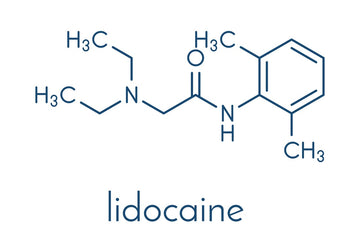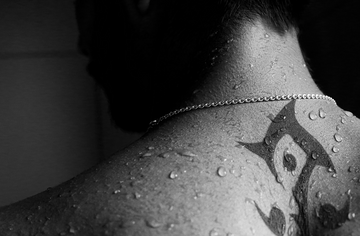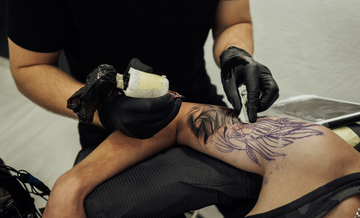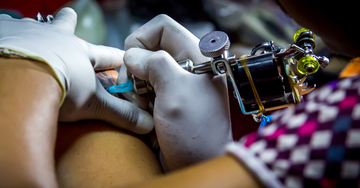Tattoo numbing creams are a game-changer for individuals who want body art but are apprehensive about the pain. These topical anesthetics promise to make the tattooing process more comfortable, but their effectiveness depends on understanding the science behind them and using them properly. This article delves into the mechanisms that allow numbing creams to work and how they interact with your body during a tattoo session.
How Pain Works During Tattooing
Mechanisms of Pain Perception
Pain is the body’s way of signaling damage or potential harm. During tattooing, needles puncture the skin repeatedly, activating nociceptors—specialized nerve endings in the skin. These nociceptors send pain signals to the brain via the spinal cord, creating the sensation of pain.
Factors That Influence Tattoo Pain
- Location: Areas with thin skin, like the ribs or wrists, tend to be more painful.
- Size and Complexity: Larger tattoos or those with intricate details require longer sessions, increasing discomfort.
- Individual Tolerance: Everyone experiences pain differently based on biological and psychological factors.
What Is Tattoo Numbing Cream?
Definition and Purpose
Tattoo numbing cream is a topical anesthetic applied to the skin before a tattoo session to temporarily reduce pain. It works by desensitizing nerve endings in the application area.
Common Active Ingredients
- Lidocaine: A fast-acting local anesthetic that blocks nerve signals.
- Benzocaine: Another topical anesthetic, often used in combination with lidocaine.
- Prilocaine: Similar to lidocaine but slower-acting, often used in extended sessions.
- Tetracaine: A longer-lasting anesthetic included in some formulations.
The Science Behind Numbing Creams
How They Block Nerve Signals
Numbing creams contain active ingredients that work by temporarily interrupting the transmission of pain signals. These ingredients penetrate the skin’s outer layer (epidermis) to reach the underlying nerve endings. By blocking sodium channels in the nerve membranes, numbing creams prevent the nerves from sending pain signals to the brain.
The Role of Lidocaine and Other Ingredients
Lidocaine, the most common ingredient in tattoo numbing creams, works within minutes of application. It reduces the excitability of nerve endings by stabilizing their cell membranes. Other ingredients, like prilocaine, are often added to extend the numbing effect or reduce inflammation in the area.
Benefits of Using Tattoo Numbing Cream
Pain Management for Sensitive Areas
For tattoos on highly sensitive areas like the ribs, feet, or spine, numbing cream can make the process significantly more bearable. It’s especially helpful for people with low pain tolerance.
Enhancing the Overall Tattooing Experience
When pain is minimized, clients can remain still and relaxed, allowing tattoo artists to focus on precision and artistry without interruptions.
Limitations and Risks
Temporary Nature of Numbing Effects
Most numbing creams provide relief for 1-2 hours, depending on the formulation and application method. Longer sessions may require reapplication, which isn’t always practical.
Potential Side Effects and Allergic Reactions
Some people may experience:
- Skin irritation or redness.
- Allergic reactions to the active ingredients.
- A sensation of burning or itching upon application.
The Application Process
How to Use Numbing Creams Effectively
- Clean the Area: Wash the skin with soap and water to remove oils or dirt.
- Apply a Thin Layer: Spread an even layer of cream over the area.
- Cover with Plastic Wrap: This enhances absorption and keeps the cream from drying out.
- Wait for Activation: Allow the cream to sit for 30-60 minutes before removing the wrap.
Best Practices for Safety and Effectiveness
- Use a patch test to check for allergic reactions before full application.
- Follow the product’s instructions carefully.
- Avoid applying to broken or irritated skin.
Artists’ Perspectives on Numbing Creams
Professional Opinions
While many artists are open to clients using numbing creams, others are cautious. Some believe the creams can slightly change the texture of the skin, making it harder for needles to deposit ink evenly.
Challenges During Tattooing
Overuse of numbing cream can make the skin overly soft or slippery, which may hinder precision during detailed work. Communication with your artist is essential.
Myths and Misconceptions
“Numbing Creams Eliminate All Pain”
While they significantly reduce pain, numbing creams don’t guarantee a completely pain-free experience. Some sensations, like pressure, may still be felt.
“Using More Cream Enhances Effectiveness”
Applying excessive amounts of cream won’t necessarily improve its effectiveness and may increase the risk of side effects.
Tattoo numbing creams work by leveraging well-studied anesthetic compounds like lidocaine to block pain signals at the nerve level. While they offer significant benefits for managing pain, their success depends on proper application and realistic expectations. By understanding how these creams function, you can use them responsibly to enhance your tattooing experience without compromising the quality of the artwork.
FAQs
1. Can Numbing Cream Affect Tattoo Quality?
Some artists believe excessive use can alter the skin’s texture, but this is rare when used properly.
2. How Long Does the Effect Last?
Most creams last 1-2 hours, depending on the product and application method.
3. Are Numbing Creams Safe for Everyone?
They’re generally safe, but people with sensitive skin or allergies should consult a professional before use.
4. Can I Use Numbing Cream for Touch-Ups?
Yes, it’s a great option for smaller touch-up sessions.
5. What’s the Difference Between Numbing Cream and Spray?
Creams are thicker and provide longer-lasting relief, while sprays are faster-acting but shorter-lived.





